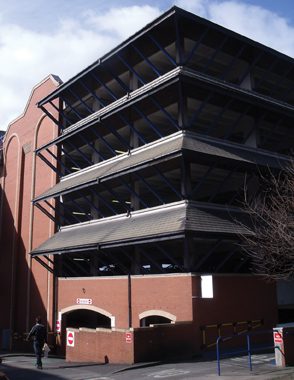Parking barriers are forecast to grow faster than any other barrier type in the global market for vehicle barriers, with growth of parking barriers in emerging regions also supported by ongoing investments in the developed markets, according to a new report from the US-based market research company IHS Inc.
Global revenue for parking barriers will grow from $110.8 million in 2012 to $158.2m in 2017, equivalent to a five-year compound annual growth rate (CAGR) of 7.4 percent, as shown in the attached figure. In comparison, revenue CAGR during the same period will equate to 2.2 percent for highways and toll barriers, to 2.0 for traffic-management barriers, and to 2.5 percent for perimeter-type barriers.
Overall revenue for the global market for vehicle barriers is projected to reach $470.5 million by 2017, up from $387.7 million from 2012, according to research contained in the report, “The 2013 World Market for Vehicle Entrance Control Equipment.” This year alone, parking purposes will account for more than 29 percent of global vehicle barrier revenue.
Automation and the increased use of off-street parking systems are the two distinct trends driving the global market for vehicle barriers. In emerging regions, the movement toward automation is a key growth factor for parking barriers. Historically, low wages in markets such as China, Southeast Asia and India have limited opportunities for automated vehicle barriers. Adi Pavlovic, analyst for vehicle entrance control equipment at IHS, says: “As average income continues to increase in these regions, automated systems are progressively replacing manual attendant solutions. This is because automated solutions are much more efficient and decrease fraud in comparison.“ China, India and Southeast Asia will see their average income rise by 41.5 percent from 2012 to 2017.
The trend toward automated vehicle barriers is also heavily tied to strong construction activity in areas like China and India, where opportunities exist for automated vehicle barriers. Cities such as Beijing, for instance, are struggling to provide enough parking spaces for its growing number of drivers, now estimated at about five million. In response to accommodate rising urbanization and rapidly growing infrastructure, the city is planning to add more than two million parking spaces in the short term. The majority of these spaces are predicted to be located off-street due to the lack of enforcement and available real estate for on-street parking.
In addition to the strong growth opportunities in emerging regions, investments continue to increase for off-street parking systems in many developed countries, such as the United States. “Off-street parking systems have benefited the most from the expansion in US commercial construction, considering the country’s large automobile and parking culture,” states Pavlovic. IHS Global Insight data estimates new construction of parking garages surged by 38 percent within the United States in 2012, with similar growth projected to repeat in 2014.
Pavlovic adds that investment in off-street parking across Europe is likewise prevalent. “Despite the developed public transportation systems and a bicycle-friendly culture, traffic congestion is still a huge issue in Western Europe. In an attempt to decrease congestion, municipalities are investing in off-street parking garages and reducing available on-street parking spots.” The mature parking retrofit market along with the trend toward converting on-street spaces into off-street is keeping the European parking industry afloat despite poor economic conditions.
Overall, several positive indicators are driving the growth of parking barriers in both mature and emerging regions. However, one of the largest barriers to entry in the emerging regions will be competition posed by local low-cost suppliers. As a result, manufacturers looking to enter these markets will need to focus on educating their customers to help them understand the importance of quality in ensuring product longevity. In particular, any downtime incurred due to malfunctions in the performance of automated off-street parking can be costly.









